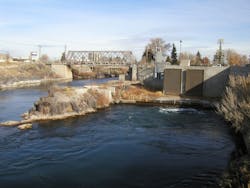Avoiding Outages with Hydropower Microgrid…More Renewables in the North American Energy Mix… And Other Quick News
A hydropower microgrid to avoid outages
Idaho Falls’ four hydroelectric plants on the Snake River can power as much as half of the city’s demand at any one time. Photo: idahofallsidaho.gov
Following its second major outage in three years, the city of Idaho Falls is evaluating a hydroelectric microgrid plan with Idaho National Laboratory (INL).
As reported by PostRegister.com, the microgrid would be powered by Idaho Falls’ four hydroelectric plants on the Snake River, which can power as much as half of the city’s demand at any one time. During a widespread outage, the microgrid would allow the city to disconnect from the larger grid and maintain critical facilities with power from the hydro plants. Large batteries would help counteract variability in demand on the microgrid.
INL and several other federal research partners have a grant to conduct more research on a microgrid for the city. INL will use its own microgrid at the Energy Systems Laboratory to model how a city-wide version would work.
Read more about the hydropower microgrid project here.
***
Navigant Research: Installed distributed energy resources capacity expected to total $1.9 trillion from 2015 to 2024
Investment in installed distributed energy resources (DER) is rapidly expanding, according to Navigant Research, representing a major shift away from the centralized, one-way electrical grid that has long been the status quo.
Navigant’s Distributed Energy Resources Global Forecast reports installed DER capacity is expected to total $1.9 trillion in investment from 2015 to 2024.
[clickToTweet tweet=”@NavigantRSRCH: Installed DER capacity expected to total $1.9 trillion from 2015-2024.” quote=”@NavigantRSRCH: Installed DER capacity expected to total $1.9 trillion from 2015-2024.”]
“Rapidly expanding DER investment has generated concern and optimism throughout the power industry as regulators and grid operators work to understand the evolving landscape,” says Mackinnon Lawrence, senior research director with Navigant Research. “The shift away from centralized generation is going to require grid operators to develop more innovative technologies and solutions.”
A more dynamic and flexible network with advanced communications and orchestration will be required to ensure stability, efficiency, and equality among diverse resources.
The report also finds that most countries are expected to see more DER capacity additions in the coming decade–largely in the form of solar PV, generator sets, and energy storage–with the ratio of DER capacity deployment compared to centralized generation expected to reach 5:1 by 2024. North America, Europe, and Asia Pacific are all anticipated to see high levels of growth in new DER resources.
An executive summary of the report is available for free download on the Navigant Research website.
***
More renewables in the North American energy generation mix: EIA projects large increase between 2015 and 2025.
Assuming the Clean Power Plan (CPP) is upheld and takes effect in the United States, the U.S. EIA’s Annual Energy Outlook 2016 projects the North American share of energy generation from renewable and nuclear energy sources will grow — from 38 percent in 2015 to 45 percent in 2025.
[clickToTweet tweet=”EIA: North American share of energy generation from renewable & nuclear energy sources will grow to 45% in 2025.” quote=”EIA: North American share of energy generation from renewable & nuclear energy sources will grow to 45% in 2025.”]
Source: U.S. Energy Information Administration, Annual Energy Outlook 2016 Reference case, International Energy Outlook 2016
Electricity generation in the United States currently represents more than 80 percent of total generation in North America. The extension of certain tax credits, significant cost reductions, and recognition of future CPP requirements result in a large increase in renewable generation between 2015 and 2025.
Canada, which already hit 80 percent clean energy power generation in 2015, plans to further increase its hydroelectric capability, in addition to its wind and solar capacity, by 2025.
Mexico is projected to increase generation from hydroelectric, wind and other renewables and to reduce generation from fossil fuels. By 2025, its combined nuclear and renewables share of total electricity generation is expected to be 29 percent.
Source: U.S. Energy Information Administration, International Energy Outlook 2016
Track news about hydro microgrids and other microgrid projects worldwide. Join us on twitter @MicrogridNews.
